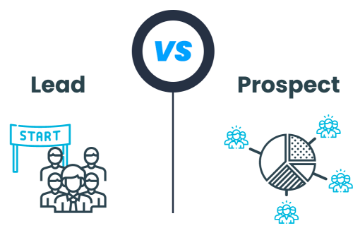Subscribe to Our Newsletter
Stay updated with the latest tips and strategies. Get additional discounts and alerts on offers.

‘Lead’ and ‘Prospect’ are the nucleus of the sales market. However, sales reps often get confused with their meanings and their appropriate usage during the sales processes. Though the terms, lead, and prospect are intertwined with each other and used interchangeably, it is important for sales reps to know the difference between them for a more effective sales strategy and execution. Misinterpretation of the two terms could lead to poor or low sales.
A lead is an unqualified contact at the top of the sales funnel. It is a piece of contact information that has shown a little interest in your service/product directly or indirectly. The information could be from a form filled, a sign-up, digital platforms, or has been provided directly, with or without the authority, resources, or intent to buy your product/service and indirectly points towards a sale.

Fun fact – Did you know that today’s sales process takes 22% longer than the process 5 years ago?
A prospect is a contact that has been qualified as an ideal buyer persona of a company, fits in well to benefit from the company’s service/product. Through regular checks and development, these leads demonstrated a strong intent of buying the company’s service/product. In other words, the prospect is the final step before the actual sale’s outcome.

Leads are characterized by one-way communication where they approach the business through a form, sign-up, or online platforms. As the company receives the contact information, they would enter the lead into the sales nurturing process, which then receives several types of communication regarding further engagement.
More qualified contacts may engage with the content, but there exists no continuous communication. Prospects, on the other hand, are characterized by two-way communication. The qualified lead would require engaging in a conversation with the sales rep. This could be in the form of emails, calls, or meetings.

The mode of communication is the second major factor to understand the difference between lead and prospect. Leads are contacted on a bulk basis, generally in large groups and automated. Whereas, associated reps contact prospects in smaller groups or individually with highly personalized messages/calls.
Read about the 8 most critical sales challenges and ways to overcome them in 2021!
The transition from a lead to a prospect is not a long journey but is integral to the sales funnel. Failure to adhere to smart tactics and improvised strategies often result in lead loss.
Fact – Do you know that 50% of qualified leads are still hesitant to turn into a buyer?
Tip – 90% of the top-performing salesperson in the USA uses Social Media interactions for customer service to turn the audience into buyers.
Get access to comprehensive prospect data.
It is suggested to take the lead through a sales qualification process before entering them into the sales nurturing process. This way, the companies, and their sales reps save a lot of time and effort in case of trying to nurture negative leads. Three steps to qualify leads before converting them into prospects.

‘Prospect’ is one of the most crucial and important parts of the sales process. It helps companies in gaining potential customers and earns you a reputation in the market as a trusted advisor. Hence, it is suggested that maintaining a clear and handy track of the prospects helps solve further unexpected concerns.
The best way to track your prospects is with a customer relationship management (CRM) database. Many great and free CRM tools are available on the internet, where you could use them according to your needs and necessities.

Benefits of tracking prospects
DataCaptive™ is a B2B database platform that provides intent-based and actionable contact and company data to ease and boosts your sales process. Design and execute data-driven solutions to generate sales-qualified leads and a higher percentage of conversion rates with DataCaptive.
Turn your leads into qualified prospects to strengthen your sales funnel and business goals by executing the best lead generation tactics and data-driven solutions from DataCaptive™. Let us know if you were benefitted from this article.
Gain a better perspective to achieve prospects.
Show Some Love!

Subscribe to Our Newsletter
Stay updated with the latest tips and strategies. Get additional discounts and alerts on offers.
Related Articles
Subscribe to Newsletter
Stay up to date with the latest marketing, sales, and service tips and news.
